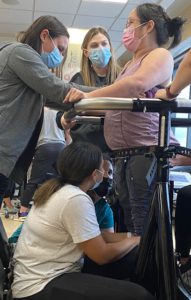The NeuroRecovery Network (NRN) held its annual summit at Frazier Rehabilitation Institute in Louisville, Kentucky last week. NeuroHope is laying the groundwork to join the network later this year, and our staff was invited to attend and learn about the innovative therapy interventions that are being researched and implemented at NRN sites across the country and overseas.
The NRN is a collaboration of clinical sites tied to rehabilitation hospitals (Craig Hospital, Frazier Rehab Institute, Kessler Institute for Rehabilitation, Magee Rehabilitation Hospital, Ohio State University Medical Center) and independent sites aimed to continue aggressive therapy and wellness for patients after they leave the hospital system (Next Step, Courage Kenny, Journey Forward, NeuroKinex).
 The inspiration to begin this unique network of sites began through the work of Dr. Susan Harkema and Dr. Andrea Behrman, whose research led to a better understanding of neuroplasticity, which is the ability of nerve cells in the central nervous system to develop new connections and learn new functions. Their work provided new evidence about the role the spinal cord plays in stepping, standing, and interpreting sensory information to re-learn tasks.
The inspiration to begin this unique network of sites began through the work of Dr. Susan Harkema and Dr. Andrea Behrman, whose research led to a better understanding of neuroplasticity, which is the ability of nerve cells in the central nervous system to develop new connections and learn new functions. Their work provided new evidence about the role the spinal cord plays in stepping, standing, and interpreting sensory information to re-learn tasks.
The Christopher and Dana Reeve Foundation (CDRF) helped fund the original research, and in the years since, the Foundation has been devoted to translating results to the clinic to help patients recovering from and living with spinal cord injury.
The NRN revolves around providing Activity-based therapy, a specific technique that activates the nervous system below the injury level and focuses on strengthening muscle weakness and neurologic recovery. In addition to specific manual techniques, a principle Activity-based intervention is Locomotor Training. Locomotor Training allows injured individuals to repetitively practice standing and stepping using body weight support. In a therapy session, the participant is suspended in a harness over a treadmill at a high speed while specially trained therapists move the legs and ankles using specific sensory cues to simulate walking. As the person gains function, improvements in sitting, standing, core strength, circulation, and bone-density may occur.
 Dr. Harkema is also a pioneer in implementing epidural stimulation in her work, which made global headlines in 2011 and 2014 for restoring movement in four spinal cord injured individuals. Since then, the NRN has incorporated new methods of NeuroMuscular Electrical Stimulation (NMES) at their sites to target upper extremity function, increase movement, and improve neuroplasticity. NMES uses parameters beyond typical electrical stimulation to excite the central nervous system and activate weakened muscles.
Dr. Harkema is also a pioneer in implementing epidural stimulation in her work, which made global headlines in 2011 and 2014 for restoring movement in four spinal cord injured individuals. Since then, the NRN has incorporated new methods of NeuroMuscular Electrical Stimulation (NMES) at their sites to target upper extremity function, increase movement, and improve neuroplasticity. NMES uses parameters beyond typical electrical stimulation to excite the central nervous system and activate weakened muscles.
Drs. Harkema and Behrman delivered lectures at this year’s summit and worked with NRN staff members from sites around the country as they practiced evaluation and activity-based therapy techniques.
 We were honored to be invited to the summit and learn from some of the best minds in the world of neuroscience. NeuroHope will soon be one of just 13 sites in the world where these innovative techniques are available.
We were honored to be invited to the summit and learn from some of the best minds in the world of neuroscience. NeuroHope will soon be one of just 13 sites in the world where these innovative techniques are available.
Learn more about the NRN below:






